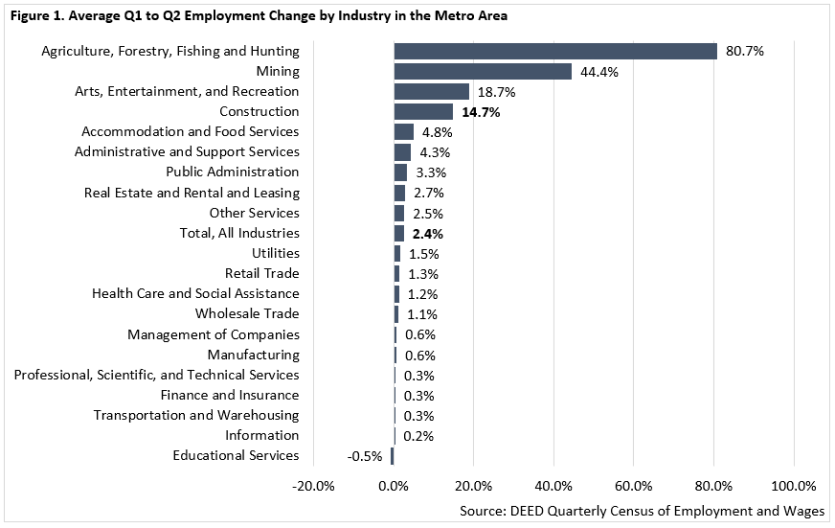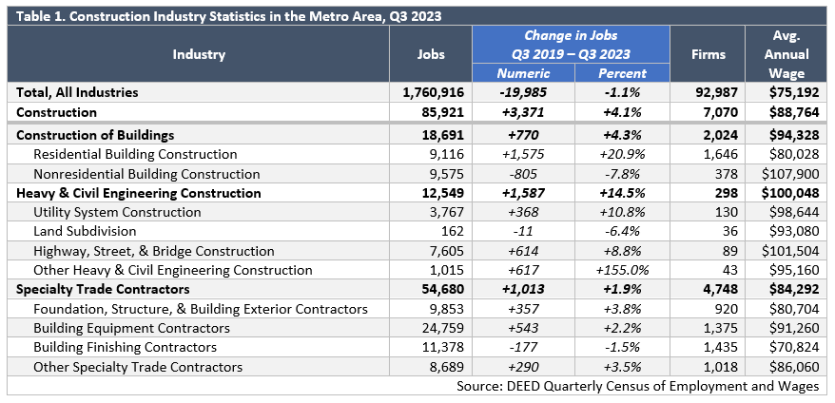 The Minneapolis-St. Paul metropolitan area is a national leader in finance, advanced manufacturing, agriculture and retailing.
The Minneapolis-St. Paul metropolitan area is a national leader in finance, advanced manufacturing, agriculture and retailing.
Medical devices, electronics and processed foods are strong suits recognized globally.
Want the freshest data delivered by email? Subscribe to our regional newsletters.
4/23/2024 1:19:18 PM
Tim O'Neill
We've officially entered the second quarter of the calendar year, which brings along drastic seasonal changes in Minnesota. This is true not only for warming temperatures, blooming flowers and trees, and the reemergence of birds and bugs, but also changes in the state's industry employment. This is especially so for an industry like Construction.
In the Metro Area, the Construction industry sector has averaged a 14.7% bump in employment between the first and second quarter every year going back to 2000 (excluding those losses witnessed in 2020 due to COVID). This is equivalent to about 8,800 additional jobs during second quarter over first quarter each year. This seasonal bump in second quarter employment far outpaces the 2.4% average increase in jobs for the total of all industries between first and second quarter each year. Only Agriculture, Forestry, Fishing, & Hunting; Mining; and Arts, Entertainment, & Recreation witness larger respective seasonal employment increases between the first and second quarters of each year. All other major industry sectors have much less variation in employment levels between Q1 and Q2 (Figure 1).

It should be noted that Construction employment reaches its typical employment heights each year during the third quarter. While the average employment gain between the second and third quarter isn't as significant as the gains between first and second quarter, Construction employment has expanded by an average of 7.2% between the second and third quarter each year since 2000 in the Metro Area. This is equivalent to approximately 5,000 jobs added each year during the third quarter.
So, let's look at the latest third quarter 2023 data for Construction in the Metro Area. As of that time, the region had over 7,000 Construction establishments supplying nearly 86,000 covered jobs. This made Construction the Metro Area's ninth largest-employing industry sector, accounting for about 5% of the region's total employment. Nearly two-thirds of these jobs (63.6%) are categorized in Specialty Trade Contractors, 21.8% are categorized in Construction of Buildings, and 14.6% are categorized in Heavy & Civil Engineering Construction. The average annual wage among all Construction jobs in the Metro Area, at $88,764, was nearly $13,600 higher than the average annual wage for the total of all jobs in the region.
While the Metro Area witnesses the reemergence of Construction employment every year in the second and third quarters, it has witnessed the reemergence of such employment at a higher level, too. Between the third quarters of 2019 and 2023, Construction employment in the Metro Area expanded by 4.1%. This was equivalent to nearly 3,400 jobs. This is during a period when total employment in the region is still aiming to recover fully from the impacts of the COVID-19 recession. Zooming in, employment expansion in Construction has been especially strong in Other Heavy & Civil Engineering Construction; Residential Building Construction; Utility System Construction; and Highway, Street, & Bridge Construction (Table 1).

For those looking to take advantage of seasonal and annual growth trends in Construction, check out CareerForceMN.com for more information on hiring events, job fairs, and training programs.
Contact Tim O'Neill, Labor Market Analyst, at timothy.oneill@state.mn.us.